For the seventy-fifth anniversary of the first artificial self-sustaining nuclear chain reaction, CHM assistant editor Esther D. Wang recaps the events leading up to that moment, highlighting the youngest and only female member of the team.
On December 2, 1942, a team of scientists at the University of Chicago silently sipped Chianti from paper cups under the west bleachers of Stagg Field. They had just achieved the first human-made self-sustaining nuclear chain reaction. Among them were Nobel laureates Enrico Fermi and Arthur Compton and notables such as Walter Zinn, who would be the first director of Argonne National Laboratory, and Leo Szilard, who coauthored with Albert Einstein the letter warning President Franklin D. Roosevelt of the Nazis’ capability of producing an atomic bomb. There was also Leona Woods, a graduate student who was the only woman of the group and, at twenty-three, also the youngest.
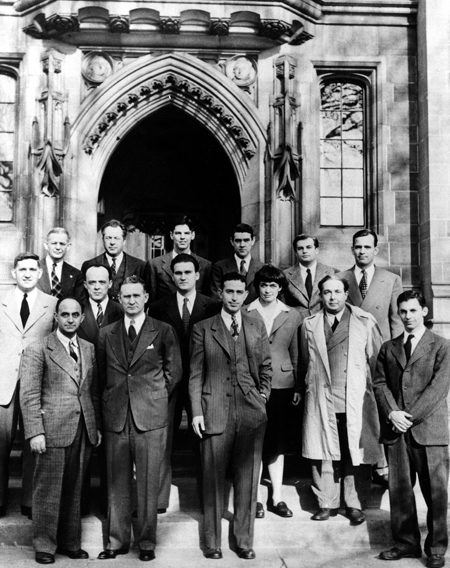
The team reunited at the University of Chicago in 1946 to mark the fourth anniversary of their achievement. Front (L to R): Enrico Fermi, Walter Zinn, Albert Wattenberg, and Herbert L. Anderson. Middle: Harold Agnew, William Sturm, Harold Lichtenberger, Leona Woods, and Leo Szilard. Back: Norman Hilberry, Samuel Allison, Thomas Brill, Robert Nobles, Warren Nyer, and Marvin Wilkening. Courtesy of the National Archives
Woods was born in 1919 in La Grange, Illinois. A precocious student, she graduated from Lyons Township High School at fourteen and earned her bachelor’s degree in chemistry at nineteen from the University of Chicago. Woods stayed to study molecular spectroscopy—the absorption of light by molecules—under Robert Mulliken, a future Nobel laureate who was knowledgeable in both chemistry and physics.
In the early 1940s, research for the Manhattan Project was underway at the University of California, Berkeley, University of Chicago, Princeton University, and Columbia University, but by early 1942, the team gathered in Chicago and was based at the Metallurgical Laboratory (Met Lab), where Woods was hired for her expertise in vacuum technology. She was tasked with building and monitoring Geiger counters—neutron detectors that gauge the progress of a chain reaction.
While Axis and Allied forces fought in Europe and the Pacific, their scientists were racing to be the first to harness the power of atomic energy. The first reactors were stacks of graphite bricks with uranium pellets called “piles.” The goal of Chicago Pile-1 (CP-1) was to prove that uranium could producing a self-sustaining chain reaction—when a neutron collides with an atom’s nucleus, splitting it and releasing energy—that could be controlled. Fermi had determined that “the reproduction factor k,” which represented the number of neutrons produced from a single neutron colliding with a target nucleus, had to be greater than 1.0 for the reaction to occur.
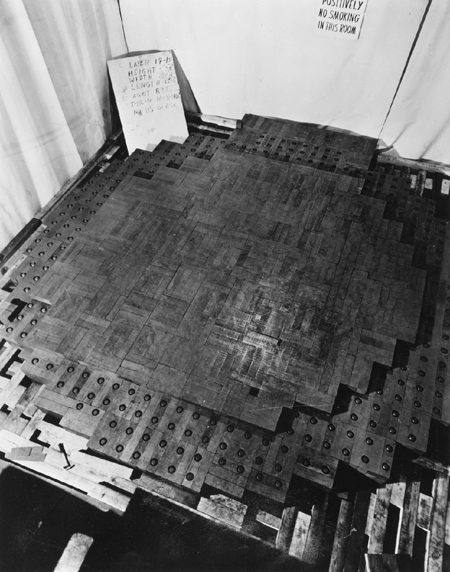
Overhead view of CP-1 during the addition of the nineteenth layer of graphite, November 1942. Courtesy of Argonne National Laboratory, ICHi-040299
By September 1942, the war entered its third year, and large shipments of uranium and graphite began arriving at the Met Lab. Within a month, staff members were working up to ninety hours a week assembling them. By November, the group was working feverishly in round-the-clock shifts, shaping 80,590 pounds of uranium oxide and 12,400 pounds of uranium metal into baseball-sized spheres that would be placed into fifty-seven layers of graphite bricks. Finally, on December 1, CP-1 was complete. At twenty feet tall, the beehive-shaped arrangement was wrapped in wood to maintain its shape and stabilized by neutron-absorbing cadmium rods.
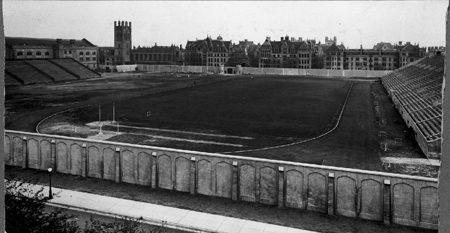
An undated photograph by Stagg Field looking southeast. The scientists worked under the bleachers on the right. CHM, ICHi-017146
On December 2, at 9:54 a.m., the first of the control rods were removed. As the neutrons increased, Woods watched the counters as they clicked faster, calling out numbers, inching ever closer to “One.” Following a final safety check at 11:25 a.m. and a lunch break, the experiment resumed at 2:00 p.m. with all of the cadmium rods being removed one by one. At 3:49 p.m., CP-1 demonstrated a k value of 1.0006, thus achieving criticality.
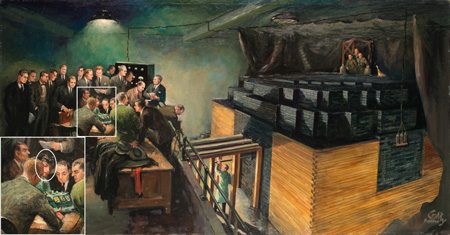
Since CP-1 was top secret, no photographers were present when it went critical. Chicago Tribune staff artist Gary Sheahan’s painting Birth of the Atomic Age (1957) was based on interviews with eyewitnesses and written reports. Woods is seated at the table (inset), and physicist George Weil is seen removing a cadmium rod from the pile. CHM, ICHi-033305
It was Eugene Wigner who had brought Chianti, so confident was he in the group’s success. After the wine was finished, the attendees signed the bottle’s straw wrapper. While the team realized the significance of their achievement, they also knew it was only the first step of many before they could produce an atomic bomb. As for Woods, her next step was to submit her PhD thesis for graduation.
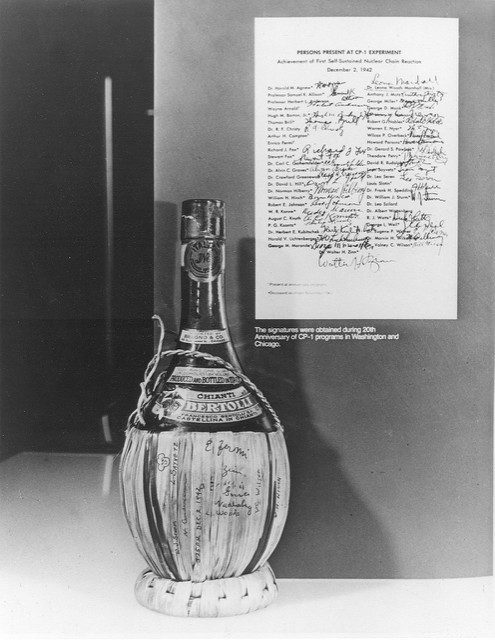
The bottle of Chianti, which was signed by the team, and a list of those present when CP-1 went critical. Photograph courtesy Argonne National Laboratory
Additional Resources
- See Nuclear Reactions, University of Chicago’s commemoration of the event
- Peruse the content of the Atomic Heritage Foundation, which preserves and interprets the Manhattan Project